In this Ultimate Guide to Piano Chords, we will cover everything that beginner needs to learn about chords. This includes the introduction, the formation of chords, triads, major & minor chords, extensions, diminished chords and tips on how to experiment and become a master of chords. Let’s Begin.
What are chords?
A chord in music refers to any two notes played at the same time. Most commonly, chords consist of three or more notes. You’ll even find advanced piano pieces that include complex five note chords, requiring the use of every finger!
Chords provide the harmony of a piece of music and are often played on the piano with the left hand, while the right hand plays the melody.
Why learn to play piano chords?
Chord playing constitutes a huge part of the piano repertoire. You’ll find chords used in countless musical styles, ranging from classical to jazz to contemporary. Many composers also find chord playing to be a great starting point for song-writing and improvisation.
Building a solid understanding of chord structure and harmony also assists with sight-reading and being able to learn new pieces faster and more accurately.
Triads
The most common type of chord used in piano playing is a triad. As its name suggests, this is a three-note piano chord. Let’s take a look at one of the most commonly used chords, the C Major triad.
We start with the C Major scale:
C D E F G A B C
To build the triad, we will take the first, third and fifth notes of the scale: C, E, and G. Play them at the same time and you have the C Major triad.
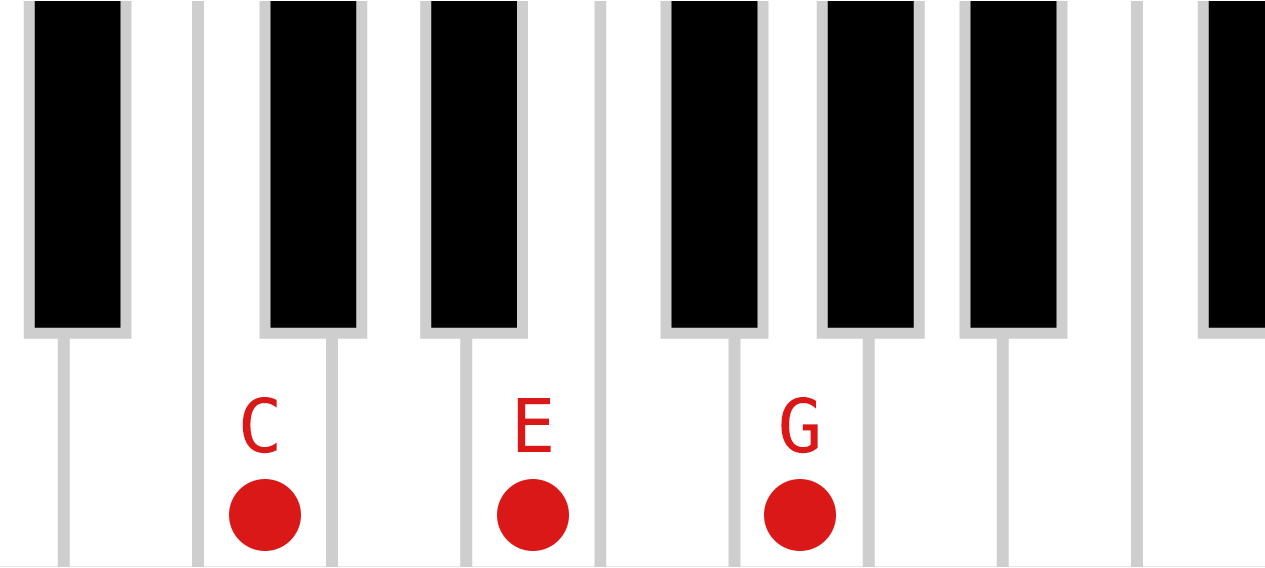
Playing Triads
For many beginner pianists, using more than one finger at a time in each hand is a big challenge. When you tried to play the C Major chord, you may have found yourself pushing down extra keys, or perhaps not hearing each note play. So let’s take a look at the C Major chord again, this time looking closely at technique.
A great way to tackle chord playing is to build up slowly. We’ll start with the right hand. Use your thumb to play Middle C and your third (middle) finger to play E. Play the two notes slowly, ensuring both keys are depressed at exactly the same time. Try to keep the hand relaxed and focus on keeping your fingers in a curved position. You should be playing with the tip of the third finger and the side of your thumb. Practice this until it is comfortable. Keep checking your hand position and listening to the sound. Can you hear both notes sounding evenly?
When you’ve mastered two notes, add G to complete the triad. Use your fifth (little) finger of the right hand. Again, keep the hand curved and relaxed. Focus on pressing down all three notes at the same time.
Let’s switch hands. To play the C Major chord in the left hand, we will use the fifth finger on C. It’s far easier to start with the stronger fingers though, so we’ll start by playing the top two notes of the chord. Place your thumb on G and your third finger on E. Just as you did in the right hand, concentrate on making an even, controlled sound. When you’re ready, add the bottom note of the chord—C— played with your thumb.
Once you’ve mastered the C Major triad in each hand, see if you can find it in different places on the piano. How quickly can you move between them?
Playing Inversions
Often pianists will rearrange the notes of a chord to alter the sound or make it easier to reach. We call this playing in inversion. When we first learn the C Major triad, we learn the notes in the order they appear in the scale— C, E, G— although playing these three notes in any order will still produce a C Major triad.
Let’s take a closer look.
Play the C Major chord as you have already learned, with C on the bottom of the chord. This is called root position.
Now, move C one octave higher. It will now be the top note of the chord, with E on the bottom. This is the first inversion.
This time, take E one octave higher. You will now have G on the bottom, C in the middle and E on top. Now you are playing in the second inversion.
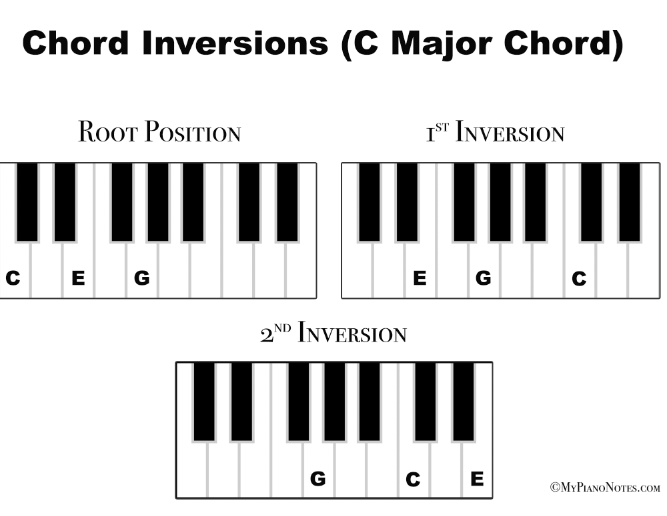
Practice finding the C Major triad in all three inversions. Don’t forget to try with both the left and right hands!
Major Triads
We can build a major triad on any note, by using the first, third and fifth notes of the major scale. As you learn each scale, it’s a great idea to find its corresponding major chord.
In most print music, the major chord is indicated by either the home note of the chord only (i.e. C) or by CM.
Here are the triads in each of the twelve major keys:
- C Major: C E G
- C# Major: C# E# G#
- D Major: D F# A
- Eb Major: Eb G Bb
- E Major: E G# B
- F Major: F A C
- F# Major: F# A# C#
- G Major: G B D
- Ab Major: Ab C Eb
- A Major: A C# E
- Bb Major: Bb D F
- B Major: B D# F#
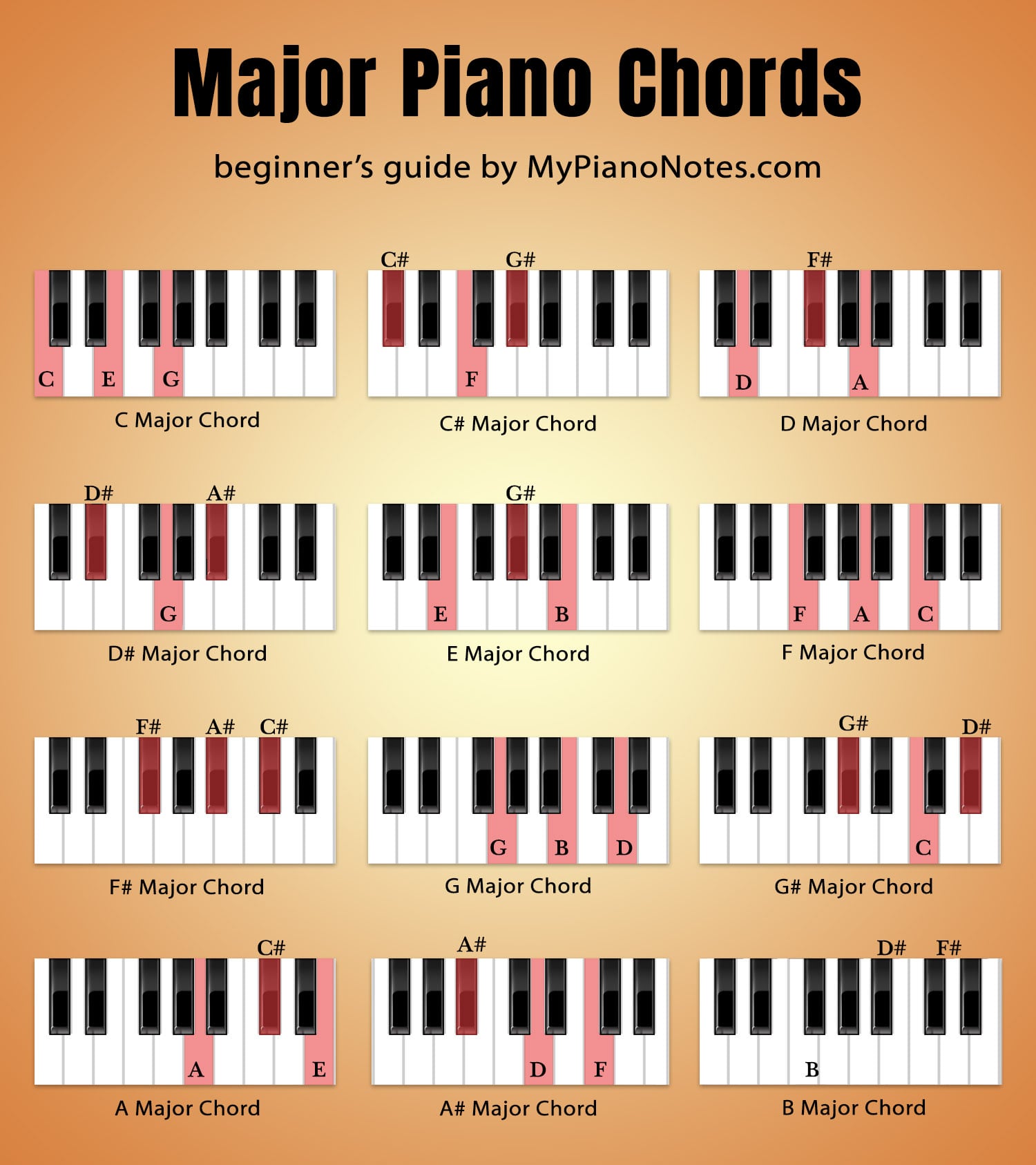
Other kinds of Piano chords
Minor triads
In the same way that we build major chords, minor triads are built from the first, third and fifth notes of a minor scale.
However, if you know a major triad of a particular key, it’s easy to find the corresponding minor triad without referring back to the scale. We simply lower the third note of the scale (the middle note of the chord) by one semitone. Remember, that’s a step down to the very next note on the piano.
Play C Major chord. Now alter the middle note from E to Eb. You are now playing C Minor triad. Listen to how the sound changes. Isn’t it amazing how changing just one note by a semitone can create such a different sound?
Minor keys are shown in print music as Cm.
Here are the minor chords in each of the twelve keys:
- Cm: C Eb G
- C#m: C# E G#
- Dm: D F A
- Ebm: Eb Gb Bb
- E Minor: E G B
- Fm: F Ab C
- F#m: F# A C#
- Gm: G Bb D
- Abm: Ab B Eb
- Am: A C E
- Bbm: Bb Db F
- Bm: B D F#
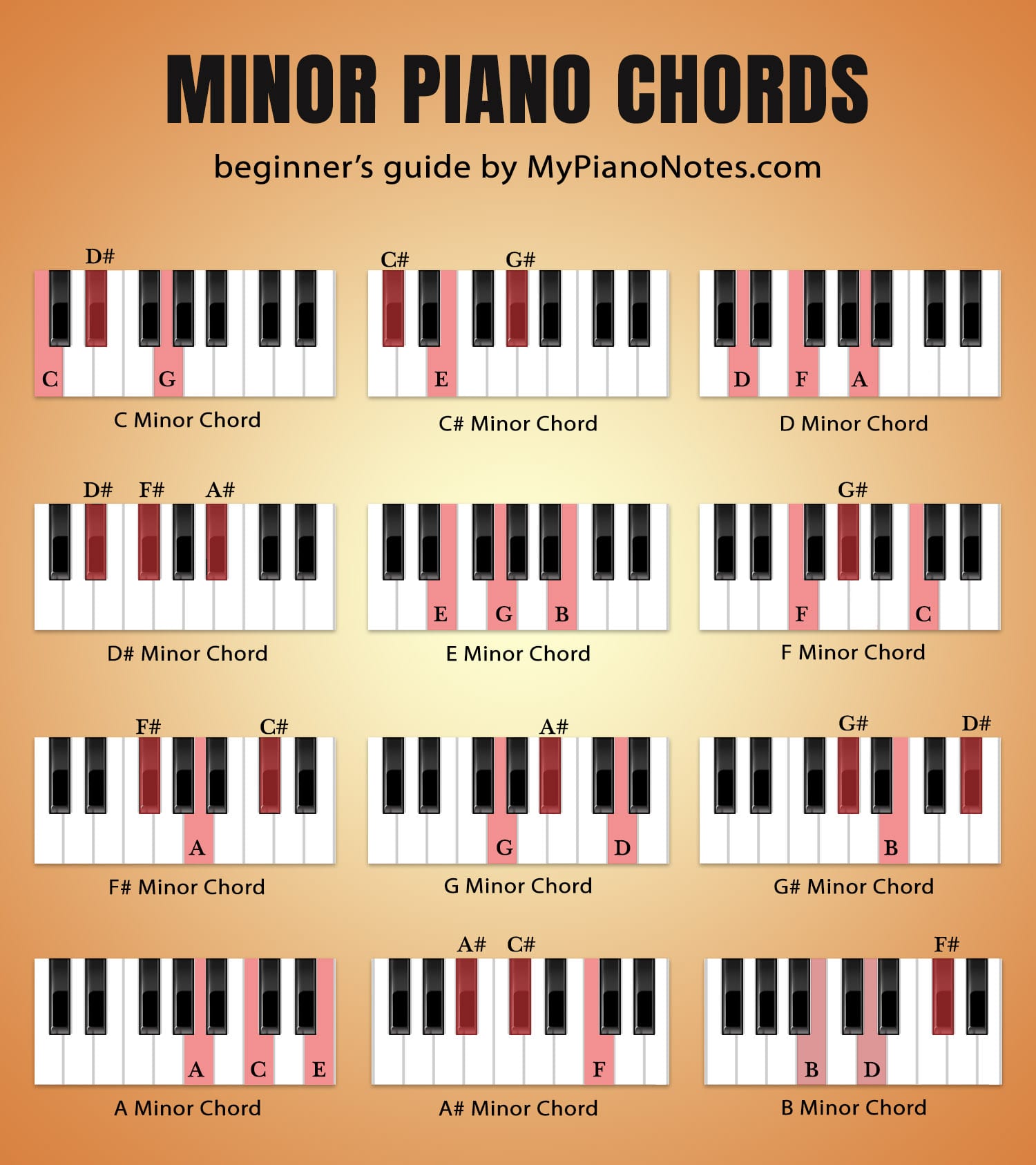
Augmented chords
To play the mysterious-sounding augmented chord, let’s again start with a major triad. We are going to move the fifth note of the scale— that’s the top note of the triad— up one semitone. Your C Major triad (C E G) will become C E G#.
You’ll see this chord written as C aug or C+.
Here are the twelve augmented chords:
- C+: C E G#
- C#+: C# F A
- D+: D F# A#
- Eb+: Eb G B
- E+: E G# B#
- F+: F A C#
- F#+: F# A# D
- G+: G B D#
- Ab+: Ab C E
- A+: A C# E#
- Bb+: Bb D Gb
- B+: B D# G
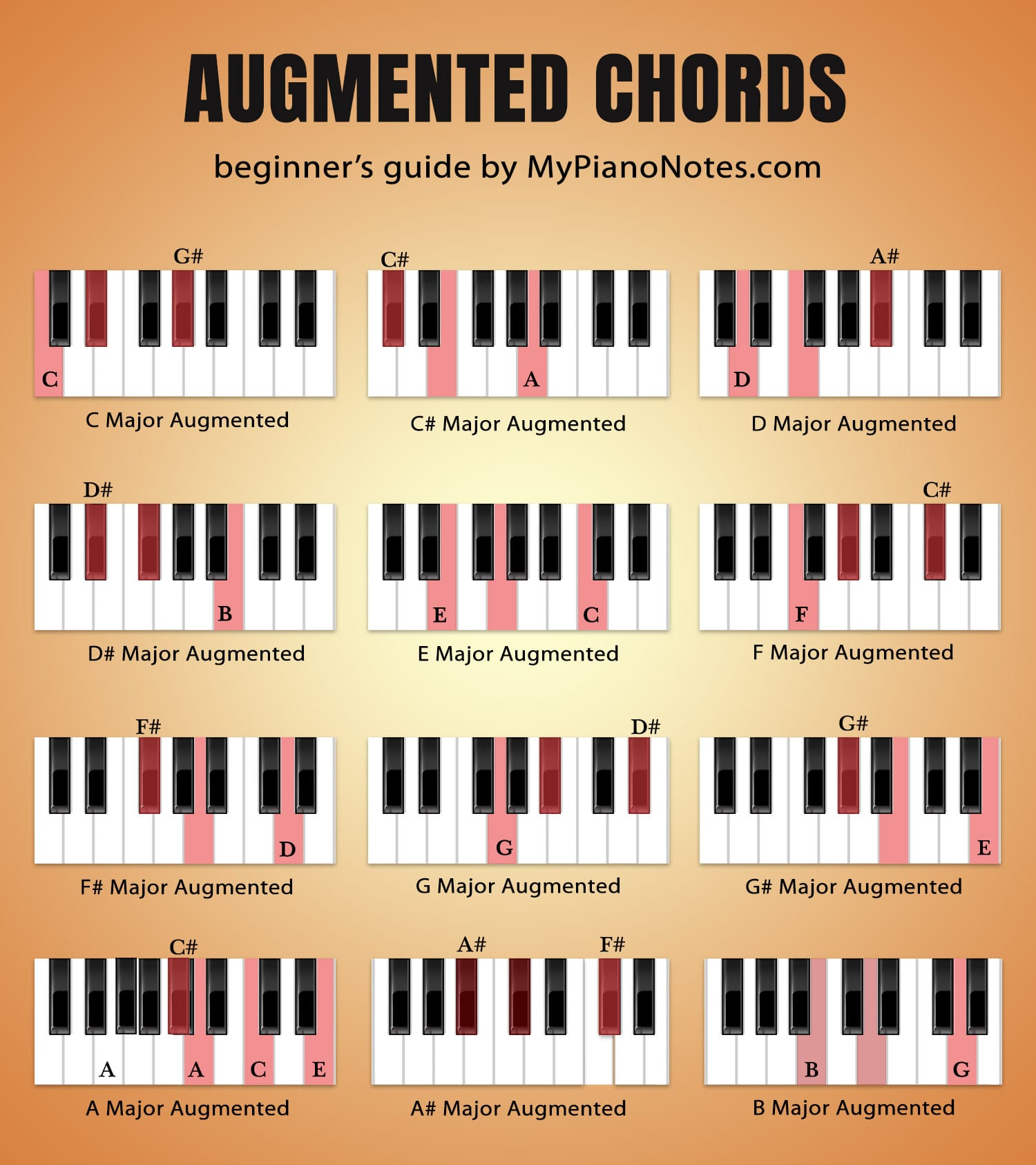
Diminished chords
To find a diminished chord, we start with the minor triad. Let’s use Cm. To alter this to a diminished triad, lower the top note by a semitone. G will become Gb. Listen to how the lowered G further darkens the sound.
Diminished chords are shown in print music as C dim or C°.
Here are the diminished chords in each key:
- C°: C Eb Gb
- C#°: C# E G
- D°: D F Ab
- Eb°: Eb Gb A
- E°: E G Bb
- F°: F Ab B
- F#°: F# A C
- G°: G Bb Db
- Ab°: Ab B D
- A°: A C Eb
- Bb°: Bb Db E
- B°: B D F
Seventh Chords
Now you’ve got the hang of three-note triads, let’s take a look at some four-note chords. Seventh chords are called as such because we add the seventh note of the scale to the triad. These chords form a huge part a jazz harmony, but you’ll see them in classical music too.
Let’s take a closer look.
Major Seventh Chords
Arguably the simplest of the seventh chords to build is the major seventh. Start with the major triad and add the seventh note of the scale, without raising or lowering anything.
Try it starting on C. The seventh note of the C Major scale is B, so we will add this note to the top of the C Major triad. So, C Major 7th becomes: C E G B
You’ll see this chord written as Cmaj7.
Here are the major seventh chords in each key:
- Cmaj7: C E G B
- C#maj7: C# F G# C
- Dmaj7: D F# A C#
- Ebmaj7: Eb G Bb D
- Emaj7: E G# B D#
- Fmaj7: F A C E
- F#maj7: F# A# C# F
- Gmaj7: G B D F#
- Abmaj7: Ab C Eb G
- Amaj7: A C# E G#
- Bbmaj7: Bb D F A
- Bmaj7: B D# F# A#
Dominant Seventh Chords
While major sevenths are the most straightforward of the four note chords, dominant seventh chords are by far the most common.
For anyone interested in music theory, it is worth exploring the harmonic basis and function of the dominant seventh chords. But for our purposes, let’s look at the dominant seventh chords in terms of how they relate to the major sevenths.
Take your C Major 7th chord: C E G B
Lower the top note by a semitone: C E G Bb
And there you have your C dominant seventh. You’ll see this in print music as either Cdom7 or, more commonly, C7.
Here are the dominant seventh chords in each key:
- C7: C E G Bb
- C#7: C# E# G# B
- D7: D F# A C
- Eb7: Eb G Bb Db
- E7: E G# B D
- F: F A C Eb
- F#7: F# A# C# E
- G7: G B D F
- Ab7: Ab C Eb Gb
- A7: A C# E G
- Bb7: Bb D F Ab
- B7: B D# F# A
Simplifying the dominant seventh chord
If you’ve been playing the piano for a few months or more, it’s likely you’ve already come across a dominant seventh chord in your repertoire. Of course, the four-note piano chords above can provide quite a challenge, particularly for students with small hands! To get around this, you’ll often see dominant seventh chords written with the fifth note of the scale omitted. Try playing the G7 chord with all four notes. Now try it again, leaving out the D. Not much difference, right?
Now, let’s take the remaining three notes of the chord— G B F— and put them into inversion. (You remember inversions, right?!) We’ll play with B on the bottom and then squeeze F and G together on the top. Try it in the left hand using your fifth finger to play B and fingers one and two for the top two notes. Much easier than the four-note version, isn’t it? Try it in the right hand using your thumb on B and fingers four and five to play F and G.
Most often, this chord will be followed by C Major. See if you can play the simplified G7 followed by C Major in root position.
You can use this technique to simplify all the above dominant seventh chords.
Minor Seventh Chords
The last of the seventh chords we’ll be looking at is the minor seventh chord.
As its name suggests, we’ll be starting with the minor triad. Just like we did for its major counterpart, add the seventh note of the minor scale to build the four-note chord. Be sure to use the natural form of the minor scale.
So, to our Cm triad— C Eb G— we will add the seventh note of C natural minor scale— Bb.
So, C minor seventh, or Cmin7, becomes: C Eb G Bb.
Here are the twelve minor seventh chords:
- Cmin7: C Eb G Bb
- C#min7: C# E G# B
- Dmin7: D F A C
- Ebmin7: Eb Gb Bb Db
- Emin7: E G B D
- Fmin7: F Ab C Eb
- F#min7: F# A C# E
- Gmin7: G Bb D F
- Abmin7: Ab B Eb Gb
- Amin7: A C E G
- Bbmin7: Bb Db F Ab
- Bmin7: B D F# A
Experimenting with chords
Now you have a huge range of chords in your arsenal, it’s time to have some fun! As mentioned earlier, a study of music harmony will greatly assist your chord playing— you’ll get a solid understanding of the functions of each of the above chords— but you can also learn plenty by simply sitting at the piano and making your own discoveries!
Don’t forget, each of the above chords can be played in inversion, so experiment in different positions and octaves.
You can extend further by playing them as broken chords— that’s playing the notes of a chord individually instead of together, or connecting chords into progressions.
Above all, have fun!
- Genda Phool - May 27, 2020
- Qismat - May 27, 2020
- Naagin (Aashta Gill) - May 24, 2020






Great Piece Boss. Piano Chords are often the trickiest part of a lesson.
Thank you for the article! It was really helpful.
Very helpful. Thanks a lot for the article.
Thanks Biswajit.
Very helpful and easy to learn thanks for your love and help 👍
Thank you for the explanations. you are the best.